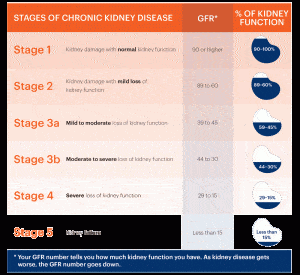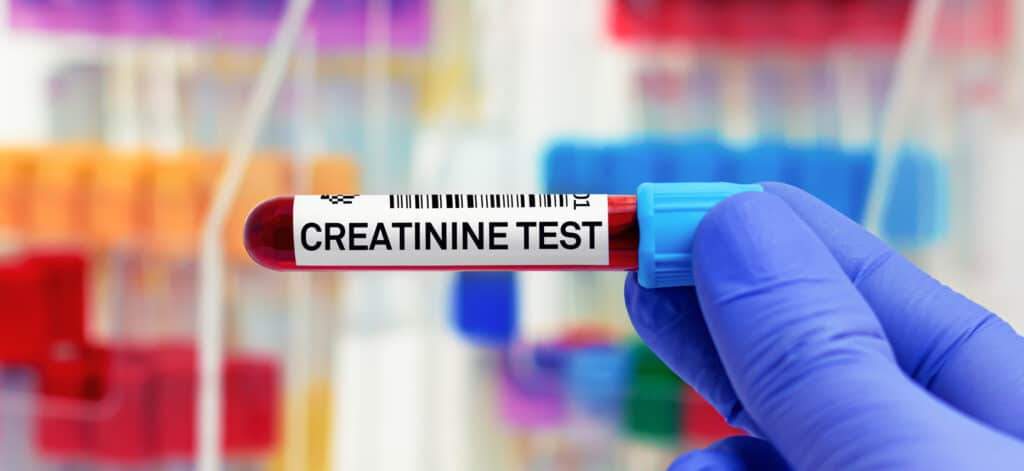The main function of the kidneys is to remove waste products from the body. One way to measure kidney function is by testing creatinine levels. High or low levels of creatinine aren’t necessarily harmful on their own but can be an indicator of serious health conditions like chronic kidney disease.
What is creatinine?
Creatinine is a waste product of creatine, a compound that provides energy to the muscles and helps improve performance. Creatine is one of the most researched compounds that’s often taken in supplement form by athletes or people with neuromuscular and heart conditions. However, most creatine comes from a diet of seafood and red meat. The liver and kidneys can also produce up to 1 gram of creatine, about half of the recommended daily amount for healthy individuals. Creatine is transported through the blood to be used by parts of the body that require a lot of energy, such as muscles and the brain.
As your muscles use energy, the tissue that produces energy in the form of adenosine triphosphate (ATP) starts to break down. The breakdown of muscle tissue causes creatinine to be released into the bloodstream. The kidneys filter creatinine and other waste products out of your blood and are then expelled from the body in urine.
The more muscle someone has, the more creatinine they produce. Men typically have higher creatinine levels than women since women have less muscle than men on average. Creatinine levels may also decrease with age or due to illness.
What to know about Creatinine levels?
Creatinine level varies based on factors like age, sex, race, and body size and depending on the test type. Creatinine can be measured either through a blood test or a urine test. Both tests allow your doctor to:
- Make a diagnosis if you are showing signs or symptoms of kidney disease
- Screen for kidney disease if you have risk factors such as diabetes or high blood pressure
- Monitor the treatment or progression of kidney disease
According to the American Kidney Fund, serum creatinine test results are measured in milligrams per deciliter (mg/dL). Typical ranges for a serum creatinine test are:
- 0.7 to 1.3 mg/dL for males
- 0.6 to 1.1 mg for females
The expected normal ranges for a urine test are:
- 955 to 2,936 milligrams (mg) per 24 hours for males
- 601 to 1,689 mg per 24 hours for females
To ensure accurate results, your doctor may ask you to fast the night before the test and stop taking creatine supplements a few days leading up to the test.
Because several factors impact these ranges, the best way to know if your kidneys are working properly is by looking at your glomerular filtration rate (GFR).

GFR shows how well the kidneys are filtering waste by measuring how much blood passes through the glomeruli every minute. The glomerulus is the filtering unit of the kidney. Because GFR is complicated and lengthy to measure, it’s usually estimated based on a specific formula. This is measurement is called eGFR (estimated GFR). A simple blood test can show eGFR.
eGFR levels can change over time and can be impacted by other factors, like dehydration. As kidney disease gets worse, levels will go down.
When weighed together with albuminuria (having too much protein in the urine), it can help determine the extent of chronic kidney disease.

What are the symptoms of high creatinine levels?
A high creatinine level isn’t usually a problem on its own but may be a sign of a potential health condition. If the kidneys aren’t functioning properly and aren’t removing waste and toxins from the body, you may experience symptoms such as:
- Changes in urination frequency and appearance
- Chest pain
- Confusion
- Fatigue
- Feeling weak
- Fluid retention and swelling, especially in the lower body
- High blood pressure
- Itchiness
- Muscle cramps
- Nausea and/or vomiting
What are the symptoms of low creatinine levels?
Low creatinine levels usually mean the body isn’t producing enough creatine. Like high creatinine levels, low creatinine levels are not usually a problem on their own but are a sign of other problems, like low muscle mass, pregnancy, or illness. Low creatinine levels can also be a sign of malnutrition.
The symptoms of low creatinine levels depend on the underlying condition. These can include:
- Low muscle mass: Difficulty exercising, lack of strength, a frail or thin body
- Liver disease: Fatigue, an inflamed liver, or nausea
- Diet: Feeling dizzy or faint, weight loss
When should you worry about creatinine levels?
You might not worry about your creatinine levels in your everyday life unless you are showing other signs or symptoms of kidney disease, such as frequent urination, blood in the urine, or muscle cramping. Most people won’t need to get their creatinine levels checked unless there is a reason for concern. However, if you start showing symptoms of high creatinine levels, especially if those symptoms last for several months, it could be due to the presence of chronic kidney disease.
According to the American Kidney Fund, 37 million American adults have chronic kidney disease, but millions of others are at risk for the disease. Because the symptoms of CKD develop slowly and are not specific to the condition, it can be difficult to diagnose, especially in the early stages. However, early detection is important to prevent the progression of kidney disease to kidney failure.
Who is at risk for chronic kidney disease?
The symptoms of CKD are similar to the symptoms of high creatinine levels, but certain groups are more at risk than others for developing the disease. You may have an increased risk for kidney disease if you:
- Are older—those over the age of 60 are more likely to develop the disease
- Have a family history of kidney failure
- Have diabetes
- Have high blood pressure
- Have cardiovascular disease
- Are obese or overweight
- Abuse over the counter medications like ibuprofen, naproxen, or acetaminophen
- Chronic use of street drugs
- Belong to certain ethnic groups like African American, Hispanic, or Native American
What causes chronic kidney disease?
The two main causes of chronic kidney disease are diabetes—both type 1 and type 2—and high blood pressure. Approximately 1 in 3 adults with diabetes have chronic kidney disease, according to the Centers for Disease Control and Prevention (CDC). High blood sugar caused by diabetes can damage blood vessels in the kidneys and the nephrons, tiny filters in the kidneys. Each nephron—there are about a million in each kidney—has a cluster of tiny blood vessels called the glomerulus that filters blood and a tubule that returns any needed substances to the blood and removes additional wastes. Damage to the nephrons causes them to stop working properly, so they can’t remove waste effectively.
High blood pressure can also cause chronic kidney disease by constricting and narrowing the blood vessels. This eventually damages and weakens the blood vessels throughout the body, including in the kidneys, according to the National Institute of Diabetes and Digestive and Kidney Diseases (NIDDKD). The reduced blood flow makes it difficult for the kidneys to remove waste and extra fluid from the body, which can then cause blood pressure to rise even more. This vicious cycle can cause even more damage to the kidneys and eventually lead to kidney failure.

What if I am diagnosed with chronic kidney disease?
If your creatinine levels indicate that chronic kidney disease is present, you might be wondering what to do next. Getting the diagnosis can be difficult and you will have questions about how to manage CKD. The best first step is learning as much as you can about your illness, like how the kidneys work, stages of kidney disease, and lifestyle adjustments, like a change in diet and exercise. Working closely with your doctor and finding a support network can help you manage day-to-day living with the condition.
Because CKD can occur alongside or cause other conditions, it is important to maintain your health. With the added risk for heart disease and the relationship between diabetes and high blood pressure, you should talk to your doctor about how to manage your risk factors for those conditions along with your CKD treatment. If you already have diabetes or high blood pressure, you will need to monitor your blood sugar. Your doctor may also suggest specific medications to help manage blood pressure and blood glucose levels.
As you come to terms with your diagnosis and begin to develop a treatment plan, you might find that you need extra support. Remember that you are not alone on your CKD journey. At PatientsLikeMe, there are over 17,000 members who are also living with chronic kidney disease. Join the conversation to learn about how others are managing their illness, what treatments they have tried, and how to live a full life – despite their condition.

